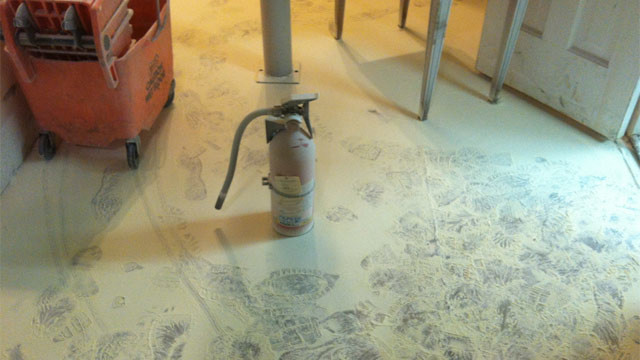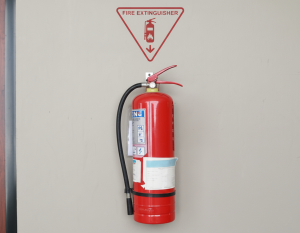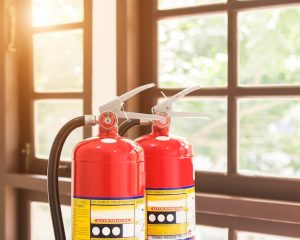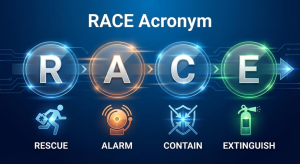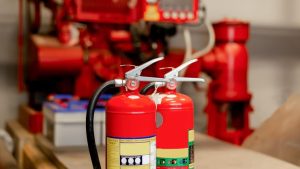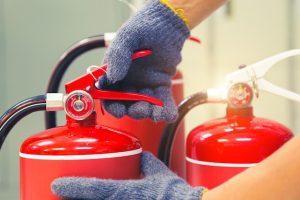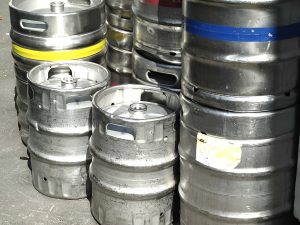Fire emergencies can be daunting, but knowing how to handle the aftermath is crucial. Once the fire is extinguished, the cleanup process begins. The type of fire extinguisher used dictates the cleanup method. Most households and businesses typically use Dry Chemical fire extinguishers, but it’s important to know the specifics of cleaning up after different types of extinguishers.
Understanding Fire Extinguishers and Their Residues
Fire extinguishers come in various types, each designed to combat different kinds of fires. Common types include:
- Dry Chemical Extinguishers: These are most common in households and commercial settings.
- Wet Chemical Extinguishers: Often used in kitchens, especially commercial ones.
- Clean Agent Extinguishers: Used in environments with sensitive equipment.
- CO2 Extinguishers: Common in industrial settings.
Each type leaves behind different residues, necessitating specific cleaning methods.
Safety First
Before starting any cleanup, ensure safety:
- Wear Protective Gear: Use a dust mask, gloves, and goggles to protect yourself from inhaling or touching any chemical residues.
- Ventilate the Area: Open windows and doors to allow fresh air to circulate and disperse any lingering fumes or dust.
Dry Chemical Fire Extinguisher Cleanup
Dry Chemical extinguishers can be based on different chemicals, each requiring a unique cleanup approach.
-
Monoammonium Phosphate-Based Extinguishers:
- Vacuum or Sweep: Start by vacuuming or sweeping the residue. Avoid using a standard vacuum cleaner as the fine particles can damage it. Use a vacuum cleaner with a HEPA filter if possible.
- Prepare Cleaning Solution: Mix hot water with baking soda to neutralize the acidic residue.
- Clean the Surface: Apply the solution to the affected area, let it sit for a few minutes, and then wipe it clean with a cloth or sponge.
- Rinse and Dry: Rinse the area with warm water and dry it thoroughly.
-
Sodium Bicarbonate or Potassium Bicarbonate-Based Extinguishers:
- Vacuum or Sweep: Remove the bulk of the residue with a vacuum or broom.
- Prepare Cleaning Solution: Mix a solution of 98% hot water and 2% vinegar. This helps neutralize the alkaline nature of the residue.
- Clean the Surface: Spray the solution on the affected area, let it sit for a few minutes, then wipe clean.
- Rinse and Dry: Rinse with warm water and dry thoroughly.
-
Silicone-Based Extinguishers:
- Vacuum or Sweep: Start by removing the dry chemical residue with a vacuum or broom.
- Prepare Cleaning Solution: Mix equal parts of isopropyl alcohol and warm water.
- Clean the Surface: Spray the solution onto the affected area, let it sit for a few minutes, then wipe clean.
- Rinse and Dry: Rinse with warm water and dry thoroughly.
Wet Chemical Fire Extinguisher Cleanup
Wet Chemical extinguishers are primarily used in kitchens to combat grease fires. Proper cleanup is essential to prevent damage to expensive kitchen equipment.
-
Safety Precautions:
- Turn Off Equipment: Ensure all appliances and fuel sources are turned off.
- Wear Protective Gear: Use rubber gloves, goggles, and a mask to protect yourself.
-
Cleaning Process:
- Initial Wipe: Use hot, soapy water to wipe down the affected areas with a sponge or cloth.
- Thorough Cleaning: Ensure no residue is left behind by thoroughly cleaning all surfaces.
- Rinse and Dry: Rinse with clean water and allow the area to dry completely before turning equipment back on.
Clean Agent Fire Extinguisher Cleanup
Clean Agent extinguishers like Ansul Clean Guard leave no residue and are used in environments with sensitive equipment, such as data centers or laboratories. Cleanup is minimal but important.
-
Safety Precautions:
- Ventilate the Area: Allow any lingering gases to dissipate by opening windows and doors.
-
Cleaning Process:
- Minimal Residue: Since these extinguishers leave no significant residue, a simple wipe down of the area with a dry cloth is usually sufficient.
CO2 Fire Extinguisher Cleanup
CO2 extinguishers are effective for electrical fires and leave no residue, but they can displace oxygen in confined spaces.
-
Safety Precautions:
- Ventilate the Area: Ensure the area is well-ventilated before re-entering.
- Wear Protective Gear: CO2 can cause frostbite; wear gloves if handling any parts of the extinguisher.
-
Cleaning Process:
- Minimal Cleanup: As CO2 extinguishers leave no residue, cleanup typically involves ensuring the area is well-ventilated and safe to reoccupy.
Proper Disposal of Fire Extinguisher Residue
Regardless of the type of extinguisher, it’s essential to dispose of the residue properly:
- Contain the Residue: Collect all residue in a plastic bag.
- Seal and Dispose: Tie the bag securely and dispose of it in regular trash, as most fire extinguisher residues do not require special disposal methods.
Preventative Measures and Maintenance
To ensure fire safety, regular maintenance and preventative measures are crucial:
-
Regular Inspections:
- Check Expiry Dates: Fire extinguishers have a shelf life; regularly check and replace any that are expired.
- Inspect for Damage: Regularly inspect your extinguishers for any signs of damage or wear.
-
Proper Storage:
- Accessible Location: Store extinguishers in easily accessible locations, ensuring they are not obstructed.
- Correct Environment: Keep them in environments that match their storage requirements, avoiding extreme temperatures.
-
Training:
- Educate Users: Ensure all household members or employees know how to use a fire extinguisher correctly using the PASS technique (Pull, Aim, Squeeze, Sweep).
- Regular Drills: Conduct regular fire drills to keep everyone prepared.
Conclusion
Cleaning up after using a fire extinguisher can be a detailed process, but it is crucial for safety and hygiene. Understanding the type of extinguisher used and following the appropriate cleanup steps ensures that your environment is safe and free from harmful residues. By taking the necessary precautions and following the correct procedures, you can effectively manage the aftermath of a fire and maintain a safe environment. For more information on fire safety and extinguisher maintenance, you can visit the National Fire Protection Association (NFPA) website or the U.S. Fire Administration’s page.
Key FAQs on Using and Cleaning Fire Extinguishers Safely
What to do after using a fire extinguisher?
Always make sure that after using the fire is extinguished, air the place, and again monitor the residual heat. Report, wipe any residue and recharge or replace the extinguisher to be used in the case of future emergencies.
Is it safe to clean fire extinguisher residue?
Yes, the residues of most fire extinguishers are not harmful to clean, but be careful. Wipe/sweep and clean surfaces with a careful procedure without spreading dust. Wear simple protection to avoid an irritation when cleaning.
Should I wear a mask when cleaning fire extinguisher powder?
Yes, wearing a mask is smart. The powder in fire extinguishers can damage the lungs and throat. A plain dust mask can assist you to breathe easily during the process of sweeping, wiping and removing the dust residue in the affected area safely.
When using a fire extinguisher, what should you aim at?
Always hit the bottom of the fire and not the fire. Attacking the source will enable you to smother the fuel and have greater control over the fire as well as a higher probability of putting the fire out in a short time frame.
What is the first thing to do when using a fire extinguisher?
The initial one is to remove the safety pin. This opens the extinguisher and makes it ready to be used. Sit somewhere where you are safe, always maintain a clear escape route behind you and use the PASS technique to use it.
Does my fire extinguisher need to be recharged after every use?
Yes. Once an extinguisher is discharged, it loses essential pressure and must be serviced. Bring it to a trusted fire extinguisher recharging place to fully recharge, test, and ensure it’s dependable for the next emergency.
Can I vacuum fire extinguisher dust?
It is possible to vacuum up small quantities of dry chemical residues though a vacuum equipped with a HEPA filter to avoid blowing dust back into the air. Clean up and sweep, then vacuum to get a safe clean up.
What should you not do when using a fire extinguisher?
Avoid turning your back on the fire, standing too close, or aiming at the flames instead of the base. Don’t continue using the extinguisher if the fire grows, and never block your escape route while operating it.

